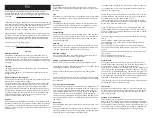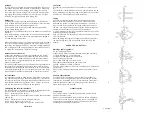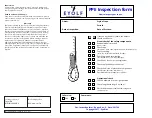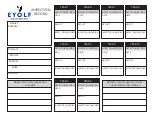
Lifespan
This is difficult to estimate but we advise as follows: Do not use
more than ten years after the date of manufacture. Assuming
you have used the correct storage, the working life can vary
from a ten year span to a single use in extreme circumstances
(e.g. highly chemical environment, serious fall, etc.). UV light
including sunlight will reduce the working life.
Anchoring
Any fall arrest anchorage used should be able to withstand a
force of 22kN when not certified or withstand at least two times
the Maximum Arrest Force when engineered.
Do not create slack in the system and avoid any pendulum
effect / swing during a fall.
Ideally the user should be attached to the anchor as vertically as
possible.
For work positioning, restraint and rescue we advise the anchor
at least hold 12kN of force for every person/device attached to
it. (Load sharing is an option)
When connecting to an anchor device or structure use a suitable
form of connector complying with EN 362, either with a shock
absorbers, complying with EN 355, a lanyard, complying with EN
354 or sling and carabiners depending on the situation you are
in. Follow the standard EN 795 for anchoring.
Harness Connection Point
Connect the lanyard to the harness preferably to the sternal
attachment point. When not possible attaching to the ventral
attachment point is allowed as long as falls are impossible or
there is a proper energy absorbance in the system, such as a
dynamic rope system.
For fall arrest equipment, such as adding an energy absorber to
the lanyard the right connection point is the Sternal or Dorsal
attachment point, indicated with the letter A on a full body har
-
ness complying with EN 361. This full body harness is the only
type of harness suitable for being used in a fall arrest system.
Fall clearance
It is important to keep in mind that the flight path is clear from
any obstacles when using a fall arresting system. It is essential
for safety to verify the free space required beneath the user at
the workplace before each occasion of use, so that, in the case
of a fall, there will be no collision with the ground.
Calculating the total fall clearance
The fall clearance is the distance required to safely arrest a fall.
It is the distance from the anchor to the ground.
Step 1 – calculate the Free Fall (F)
Step 2 – determine from the label how much the shock absorber
deploys (D)
Step 3 – determine the stretch of the harness (H)
Step 4 - add a safety factor of 2m (S)
Step 5 - add all figures together to get the clearance (C)
C=F+D+H+S
Fall Factor
A fall factor is an expression of the seriousness / severity of a
fall.
The fall factor is calculated based on how much distance can be
fallen, divided by the length of rope or lanyard used in a system.
A fall factor 2 is dangerous and could be lethal!
Falling
It should be clear that falling should be avoided at all times.
Where fall arrest systems are to be used, make sure you un
-
derstand the system so that the work carried out is done in a
way to minimize any potential fall. Keep anchor points above
the user, use only a full body harness with a dorsal D-ring as an
attachment, and make sure you have a fall clearance.
It is also important to avoid any pendulum effect during a fall as
a sideward fall is unpredictable.
With our Y-lanyard it is advised to minimize the amount of slack
near a fall hazard.
When adjusting the length of a lanyard to avoid the risk of fall,
the user should not move into an area where there is a fall
hazard.
OUR ADVICE: DO NOT FALL!
Markings and/or symbols
On our label you will find:
Product name, Product number (example B20) and assembly:
I = single lanyard or Y = Y style lanyard
E6 stands for 6kN Maximum Arrest Force
4 or 6 for length of lanyard
SH for snap hook and H for tower hook
DOM (date of Manufacture) in year and month
Serial # - Individual serial # or batch #
CE mark, which stands for “Conformité Européenne” (“European
Conformity”).
EN 355 is the European standard to which the product is certi-
fied.
Country of destination
It is essential for the safety of the user that if the product is
re-sold outside the original country of destination the reseller
shall provide instruction for use, for maintenance, for periodic
examination and for repair in the language of the country in
which the product is to be used.
Product specific
Prusik Loop
The Tak Prusik loop is specifically designed to tie off a Prusik
knots onto another rope.
Make sure you understand the Prusik knots before using them.
Test the knot on the rope you are going to use it and keep an
eye out for environmental impact as condistions of the ropes
will change the behaviour of the knot.
1
2
3
4
5 - 3 Wrap Prusik knot





